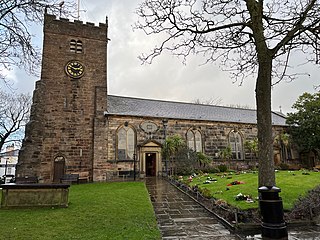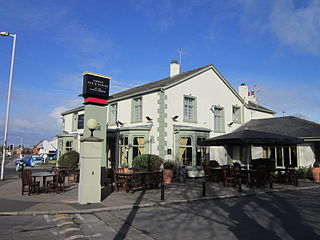
Poulton-le-Fylde, commonly shortened to Poulton, is a market town in Lancashire, England, situated on the coastal plain called the Fylde. In the 2021 United Kingdom census, it had a population of 18,115.

Warton is a village on the Fylde in Lancashire, England.

Bispham is a village on the Fylde coast in the Borough of Blackpool in Lancashire, England.

Staining is a village and civil parish in Lancashire, England, on the Fylde coast close to the seaside resorts of Blackpool and Lytham St Annes, and the market town of Poulton-le-Fylde. At the 2011 Census, it had a population of 2,290. Historically, the village was part of the township of Hardhorn-with-Newton. Now the hamlet of Newton is part of the civil parish of Staining; Hardhorn belongs to Poulton-le-Fylde.

Hambleton is a village and civil parish in the English county of Lancashire. It is situated on a coastal plain called the Fylde and in an area east of the River Wyre known locally as Over Wyre. Hambleton lies approximately 3 miles (4.8 km) north-east of its post town, Poulton-le-Fylde, and about 7 miles (11 km) north-east of the seaside resort of Blackpool. In the 2001 United Kingdom census, the parish had a population of 2,678, increasing to 2,744 at the 2011 census.

South Shore is an inner-suburb of Blackpool in the Borough of Blackpool, Lancashire, England. It forms the southern part of both the town and is situated along New South Promenade between Blackpool and Squires Gate.

Bispham Parish Church, also known as All Hallows Church, is a Church of England parish church located in Bispham, Blackpool, Lancashire, England, known as the Mother Church of Blackpool.

St Michael's Church is in the town of Kirkham, Lancashire, England. The church is recorded in the National Heritage List for England as a designated Grade II* listed building. It is an active Anglican parish church in the diocese of Blackburn, the archdeaconry of Lancaster and the deanery of Kirkham.

St Nicholas Church is in the village of Wrea Green, Lancashire, England. It is an active Anglican parish church in the deanery of Kirkham, the archdeaconry of Lancaster and the diocese of Blackburn. Its benefice is combined with those of St Matthew, Ballam and St Michael, Weeton. The church is recorded in the National Heritage List for England as a designated Grade II listed building.

Blackpool is a seaside town and unitary authority situated on The Fylde coast in Lancashire, England. This list includes the listed buildings in Blackpool and Bispham, a village within the borough of Blackpool. One is classified by English Heritage as being in Grade I and five in Grade II*. In the United Kingdom, the term "listed building" refers to a building or other structure officially designated as being of special architectural, historical or cultural significance. These buildings are in three grades: Grade I consists of buildings of outstanding architectural or historical interest; Grade II* includes particularly significant buildings of more than local interest; Grade II consists of buildings of special architectural or historical interest. Buildings in England are listed by the Secretary of State for Culture, Media and Sport on recommendations provided by English Heritage, which also determines the grading.

Poulton-le-Fylde is a market town in the Wyre district of Lancashire, England, situated on a coastal plain called the Fylde. There are 16 buildings and structures in the town which have been listed by the Secretary of State for Culture, Olympics, Media and Sport as being of special architectural, historical or cultural significance. One is classified as Grade II*, and the rest as Grade II; Poulton-le-Fylde has no Grade I listed buildings. The Grade II* designation is for St Chad's Church. There is written evidence of a church on the site since 1094, although it may have been built earlier. It became the Anglican parish church at the time of the Reformation and was largely rebuilt in the 18th century.

St Chad's Church is an Anglican church in Poulton-le-Fylde, Lancashire, England. It is an active parish church in the Diocese of Blackburn and the archdeaconry of Lancaster. It is recorded in the National Heritage List for England as a designated Grade II* listed building. A church on the site was built no later than the 11th century and may have existed prior to the Norman conquest of England. The tower dates from the 17th century, and much of the remainder of the building from a major renovation in the 18th century, although some of the fabric of the original structure remains. Further renovation and additions took place in the 19th, 20th and 21st centuries.

Holy Trinity Church is an Anglican church in Blackpool, Lancashire, England. Completed in 1895, the present church replaced one from 1836. Designed by Richard Knill Freeman in the Decorated Gothic style, it has been designated a Grade II listed building by English Heritage. It is an active parish church in the Diocese of Blackburn, the archdeaconry of Lancaster and the deanery of Blackpool.
Marton is a settlement on the coastal plain of the Fylde in Lancashire, England, most of which is now part of the seaside town of Blackpool. Marton, which consisted of Great Marton, Little Marton, Marton Fold and The Peel, was originally part of the parish of Poulton-le-Fylde, before the development of Blackpool as a resort.

Carleton is a village on the coastal plain of the Fylde in the Borough of Wyre in Lancashire, England. It consists of Great Carleton, Little Carleton, Norcross and Whiteholme and is situated close to Poulton-le-Fylde. Other nearby settlements include Thornton, Bispham and Blackpool. Historically, Carleton was in the parish of Poulton-le-Fylde. It borders the Borough of Blackpool immediately to the west.

St Peter's Church is in the seaside town of Fleetwood, Lancashire, England, situated on the Fylde coast. It is an active Anglican parish church in the Diocese of Blackburn. It was completed in 1841, to a design by Decimus Burton. Burton had been employed by Peter Hesketh-Fleetwood in 1836 to lay out the new planned town of Fleetwood. It is protected as a Grade II listed building.

St Anne's is a church in the village of Woodplumpton in Lancashire, England. It is an active Anglican parish church in the Diocese of Blackburn, and the archdeaconry of Lancaster, and the deanery of Garstang. The church is recorded in the National Heritage List for England as a designated Grade II* listed building. The churchyard at St Anne's is the supposed burial place of a 17th-century alleged witch named Meg Shelton.

St Cuthbert's is an Anglican church in Lytham, Lancashire, England. It was built 1834–1835, replacing a previous church on the same site. It is an active parish church in the Diocese of Blackburn. Since 1971 it has been designated a Grade II* listed building.

St Anne's Church is an Anglican church in St Anne's-on-the-Sea, a town on the Fylde coastal plain in Lancashire, England. It is an active Church of England parish church in the Diocese of Blackburn and the archdeaconry of Lancaster. It is recorded in the National Heritage List for England as a designated Grade II listed building.

The Borough of Blackpool is a unitary authority area with borough status and unparished area in the ceremonial county of Lancashire, England. It is named after the seaside town of Blackpool but covers a wider area which includes Anchorsholme, Bispham, Layton, Marton and Squires Gate. As well as the suburbs of Grange Park, North Shore, South Shore and Starr Gate. The borough also forms the core of the wider Blackpool conurbation.




















